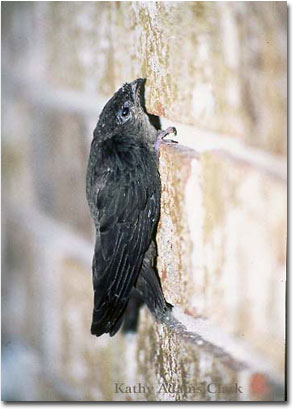|
|
 Species Profile... A Swift Return for Spring Text Copyright Gary Clark
Chimney swifts will begin arriving by late March. Kathy and I are building a chimney -swift tower, since our chimney isn't suitable for their nest-building. More about that later. We want to attract chimney swifts to our neighborhood for the same reason we attract purple martins: both martins and swifts have a voracious appetite for pesky flying insects. Chimney swifts, in particular, gobble up mosquitoes. The more chimney swifts, the better. Flocks of the little gray-black birds swirl through our neighborhood skies on summer days, especially at dusk when flying insects are abundant. When I look up at them, I think of how people often describe the birds as looking like "flying cigars." I think they look like squadrons of miniature black falcons. Like falcons, chimney swifts are fast, agile flyers that can move 150 mph. No wonder they're called swifts. Unlike falcons, swifts circle through the air in groups of 20 or 30, creating a whirling smoke-ring pattern. Of course, chimney swifts aren't falcons. Nor are they swallows like the purple martins and the barn swallows with which they share spring and summer skies. They're actually in the same scientific order as hummingbirds; they're Apodiformes, because of the similar wing anatomy of short arm bones and long phalanges. In flight, the narrow, 12-inch wings of swifts crook backward on a relatively small, chunky, 5-inch-long body. The sleek, curved wings on the stout body form the outline of a little bow and arrow. And like arrows shot from a bow, swifts dart through the sky. Swifts speed through the air in relentless pursuit of flying insects. They have stiff, hair-like feathers on the corners of their mouths that funnel insects into wide, gaping beaks. Swifts gulp down thousands of insects a day, and each swift can hold 600 insects at a time in its throat. These aerial pest exterminators arrive in Houston in the spring from wintering grounds in western Peru and the upper Amazon Basin. They breed across the United States east of the Rocky Mountains and into southeastern Canada. Swifts that breed in the Western United States include the white-throated swift in the Big Bend area of Texas and the Western mountains. The Vaux's (pronounced, voh's) swift breeds in old growth forests of the Pacific Northwest. The largest but rarest North America swift is the black swift that's limited to shady cliffs in the Colorado Rockies, Northern California and the Pacific Northwest. Chimney swifts are the only species that breed in the East. They once bred strictly east of the Mississippi River where they nested in tree hollows. Their breeding range increased as industrialization and urbanization in the East and Midwest created human-made hollows such as chimneys, silos, open wells, and barns. Swifts adapted their nesting habits to these artificial structures. Home-style chimneys became the preferred nesting shafts for swifts. The habit of the birds returning each year to nest in people's chimneys is how they got the name chimney swifts. Because of their tiny feet, swifts cannot perch on wires or tree limbs like most other birds. Instead, they cling to rough-hewn vertical surfaces like the interiors of masonry chimneys. The swift clamps itself to a vertical surface with sharp toe claws and braces its body against walls with spiked shafts in the tail called rachises. A female chimney swift constructs her nest right against a vertical surface. She assembles the nest from scores of small twigs no bigger than her feet. She molds the nest into the shape of a half saucer and glues it against the side of a wall with her saliva. The female lays three to five eggs in the nest and takes turns with the male incubating them. The chicks hatch in about 18 days and leave the nest in 30 days to fly with their parents to attack the insect population. If you have a masonry chimney, welcome the swifts to nest. They'll abate the mosquito population and help keep your chimney clean. Later this month or in early March, have a chimney sweep clean out the flammable creosote that has built up on chimney walls during the winter. Ask the sweep to remove the chimney cap so swifts can enter the shaft to nest. Close the damper to keep twigs from falling into your fireplace and to muffle the chattering of baby chicks. After the swifts leave in the fall, have a chimney sweep clean out the nesting material, re-clean your chimney and replace the cap. Many homes built in the last 20 years have chimneys with metal interiors. Such is the case at our home. The swifts can't cling to these slick surfaces or attach their nests. That's one reason the population of chimney swifts has declined in recent years. Whether you have a metal chimney or simply don't want swifts nesting in your masonry chimney, you can still create a home for swifts by building a chimney swift tower. You can build it out of textured plywood - the simplest method - or you may construct it with cinder blocks, coating the interior with masonry sealer. The tower should stand at least 8 feet high to allow swifts a nesting spot deep enough to protect them from harsh weather and summer sun. Make the tower's internal opening 11 inches to 20 inches and seal the bottom to keep out such predators as raccoons and feral cats. Stabilize it in a concrete foundation. Gary Clark and Kathy Adams Clark - NPN 134 Gary Clark's articles appear each week in the Wonders of Nature column in the Houston Chronicle. Kathy Adams Clark is a professional nature photographer who teaches photography courses and is a member of the Board of Directors of the North American Nature Photography Association. Visit their web site at www.kathyadamsclark.com. Comments on NPN wildlife photography articles? Send them to the editor. |
|
|
